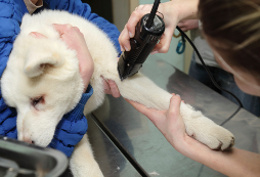Dogs can sustain an injury to the shoulder joint or the adjoining tendons due to excessive running or jumping. An injury to the shoulder joint can cause the affected dog to limp, or lift one of the paws continuously while walking. This Buzzle article will give you a brief idea about why and how dogs can receive a shoulder injury, along with the symptoms and treatment of this condition.

Did You Know?
Unlike humans, dogs do not have collarbones connecting to their shoulder blades. The absence of this bone allows them to stretch their forelegs extensively even while running.
In dogs, shoulder injuries are quite common, as they can be quite energetic at times. In dogs and other four-legged animals, the shoulder joint is the place where the scapula or the shoulder blade meets the humerus or the upper bone of the foreleg.
The humerus directly fits into the shoulder socket, thereby allowing a dog to stretch its forelegs even while running or leaping forward. An injury to the shoulder joint or the adjoining tendons can cause a dog to limp in an attempt to not place pressure on his forelimbs. This can make many pet owners suspect a foreleg injury. But they often forget to take into account that shoulder injuries can also cause limping or lameness in dogs.
More About Shoulder Injuries
✧ Biceps brachii tenosynovitis is a common shoulder problem that can develop over a period of time. This condition is characterized by the inflammation of the tendons of the biceps brachii muscle and its sheath located in front of the shoulder blade. This condition is more common in athletic dogs and medium to large, mature dogs. It is usually caused by the repetitive injury to the tendons.
✧ Supraspinatus insertionopathy or tendinopathy is another type of shoulder injury, where the supraspinatus tendon gets strained or torn. The tendon can also get inflamed and this may be followed by the formation of calcium deposits, which is known as the mineralization of the supraspinatus tendon. The supraspinatus tendon is responsible for shoulder extension.
Apart from these, contracture of the infraspinatus muscle, myopathy of the teres minor muscle, carpal injury, supraspinatus avulsion, and medial shoulder instability are some other types of shoulder problems that can affect dogs.
What Causes Shoulder Injuries in Dogs
✧ Shoulder injuries are usually caused by the direct or indirect trauma (such as repetitive strain injury) to the shoulder area. In general, shoulder injuries are caused by the overuse of the muscles that support the shoulder bones. Activities like excessive jumping or running can strain the muscles or tendons of the shoulder joint.
✧ Sometimes, a strenuous activity can also cause an injury to the shoulder joint, which is quite common in previously inactive or lazy dogs. An attempt to do an intense physical activity or exercise all of a sudden, can result in muscle and joint sprains. This is particularly true for overweight or obese dogs, as they have to put more pressure on the shoulder joint while jumping or running.
Common Signs and Symptoms
✧ Though symptoms can differ depending on the nature and extent of the injury, a dog with an injured shoulder usually shows a reluctance to do any activity that puts pressure on the front legs. Such an injury can also compel a dog to limp.
✧ Lameness associated with a shoulder injury can be mild or severe, and it can exacerbate with exercise and other weight-bearing activities.
✧ Sometimes, lameness can be subtle and intermittent as well, especially when the tendons of the biceps brachii muscle get affected.
✧ An active dog can suddenly hesitate to jump or run due to a shoulder injury. He may lift one of the paws continuously while walking. His steps can also get shortened.
✧ Apart from these, an injury to the shoulder area can also cause swelling. So, if you observe carefully, your dog’s shoulder may not look even if he has received a shoulder injury.
✧ Sometimes, a dog can be observed to bob his head or move his shoulder frequently, which can also indicate a shoulder injury.
Diagnosis and Treatment
Minor injuries generally subside within a few days without treatment. But if the condition does not improve, and the dog exhibits the signs of severe pain, then a veterinarian should be consulted at the earliest. Veterinarians usually take an X-ray of the shoulder to evaluate the condition. MRI and ultrasound can also be carried out to identify the type of injury, and detect the presence of calcium deposits.
Apart from these, a joint tap and arthroscopy may be required at times to find out the nature and the extent of the injury. These diagnostic tests can help rule out other conditions that can produce similar symptoms. One such condition is ‘osteochondrosis’, which is an orthopedic disease of the joints.
The treatment of shoulder injuries depends on the extent of the damage. The pain and swelling caused by a mild injury go away within a week or so without any medical intervention. To reduce mild pain, you can apply hot or cold packs on the affected area. But anti-inflammatory drugs may be required at times to alleviate severe pain and inflammation. In the meantime, restrict your dog from doing any physical activity that can put pressure on the shoulder joint.
When the injury is severe in nature, and your dog does not respond to non-invasive treatment, your veterinarian may suggest surgery. The rupture of the bicep tendons, as well as their mineralization may necessitate surgical intervention. Surgery can also be required to treat an avulsion or fracture of the tendon of the shoulder muscle.
While treating your dog for any kind of shoulder injury, be sure to give him enough rest so that the injury can heal completely. Talk to a veterinarian to know what activities are allowed, and what restrictions need to be maintained during the course of treatment.
To detect canine shoulder injuries in the early stage, it is important to take any kind of change in their behavior seriously. A sudden change or reduction in the level of activity can indicate an injury to the shoulder or other parts of the body. Apart from these, it needs to be kept in mind that overweight dogs are more prone to suffer from shoulder injuries. Therefore, encourage your dog to do some exercises. But do not start a rigorous exercise schedule all of a sudden. Instead, adopt a gradual approach to exercising.
Disclaimer: This article is for informative purposes only, and should not be treated as a substitute for the medical advice of a veterinarian.










RSS